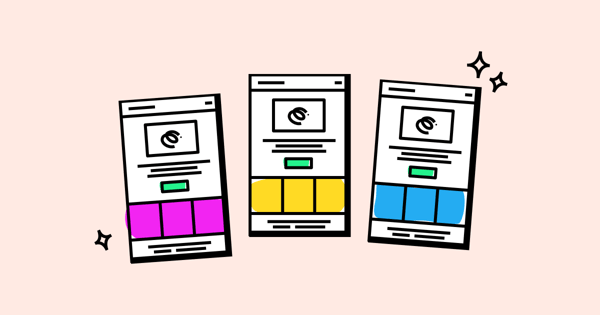Back before the internet was a “thing”, people did virtually all of their shopping at local stores.
(Hard to believe, I know.)
They’d visit the same mom-and-pop retailer once a week for years on end.
So, naturally, they’d develop a rapport with the people who worked there.
The staff might order more of their favorite types of products, reward their loyalty with special offers, and recommend new products and services based on their previous purchases.
(Incidentally, that’s still a big motivator, with 28 percent of consumers saying they shop locally because the customer service is better.)
Obviously, times have changed somewhat.
A lot of independents have been squeezed out by multinational corporations, not to mention the fact that ecommerce is expected to make up close to a quarter of total global retail sales by 2025.
But one thing that hasn’t changed is our desire for tailored customer service.
According to McKinsey, 71 percent of consumers expect companies to deliver personalized interactions—and 76 percent get frustrated when this doesn’t happen.
Yet as few as 12 percent of brands believe they actually do a good job at providing those much-sought-after personalized experiences, according to retail technology company Bluecore.
Eager to bring a more personal touch to your ecommerce marketing strategy?
One of the most effective ways for brands to deliver a personalized experience is through dynamic email marketing.
In this article, I’m going to discuss what that actually means, then take a look at seven real-world examples of brands using dynamic emails to engage customers, build longer-lasting relationships, and drive sales.
Table of Contents
- 1. Brooklinen: Give Personalized Product Recommendations
- 2. Too Faced: Re-Engage Shopping Cart Abandoners
- 3. Kina and Tam: Create Dynamic Subject Lines
- 4. Chairish: Celebrate Customer Loyalty
- 5. Sephora: Share Loyalty Program Updates
- 6. Fabletics: Boost Engagement With Dynamic Imagery
- 7. Design Within Reach: Share Dynamic End-of-Sale Alerts
What Is Dynamic Email Marketing?
Dynamic emails are those that incorporate dynamic content.
That can be any sort of email content that changes based on customer attributes and behaviors, such as:
- Demographic information, like their age, location, or job
- Their previous purchases
- The content they interact with on your website
- Their stage in the buyer cycle (have they just signed up for your newsletter? Are they a regular customer? Have they just abandoned their shopping cart?)
To be clear, dynamic content isn’t limited to your email body copy.
It can also include:
- Subject lines
- Calls to action
- Product imagery
- Video content
- Other visual elements
Basically, anything that can be customized to make your email more relevant and engaging to individual subscribers.
And with 91 percent of consumers saying they’d be more likely to shop with brands that recognize and remember them and go out of their way to provide relevant offers and recommendations, it’s clear that dynamic content is a massive win for online retailers.
7 Real-Life Dynamic Email Examples
Like what you’ve read so far about dynamic email marketing?
Then let’s take a look at seven brands that are already doing it and dig into the strategies they’re using:
1. Brooklinen: Give Personalized Product Recommendations
One of the simplest and most impactful forms of dynamic email content is the personalized product recommendation.
It’s not hard to imagine why emails containing personalized recommendations—based on the recipient’s previous purchases or the product pages they’ve visited—are more effective than those with generic recommendations.
Barilliance put some numbers to this phenomenon, discovering that customer sessions that contain zero engagement with personalized product recommendations have an average order value of about $44. That figure climbs to more than $400 for sessions with five such interactions.
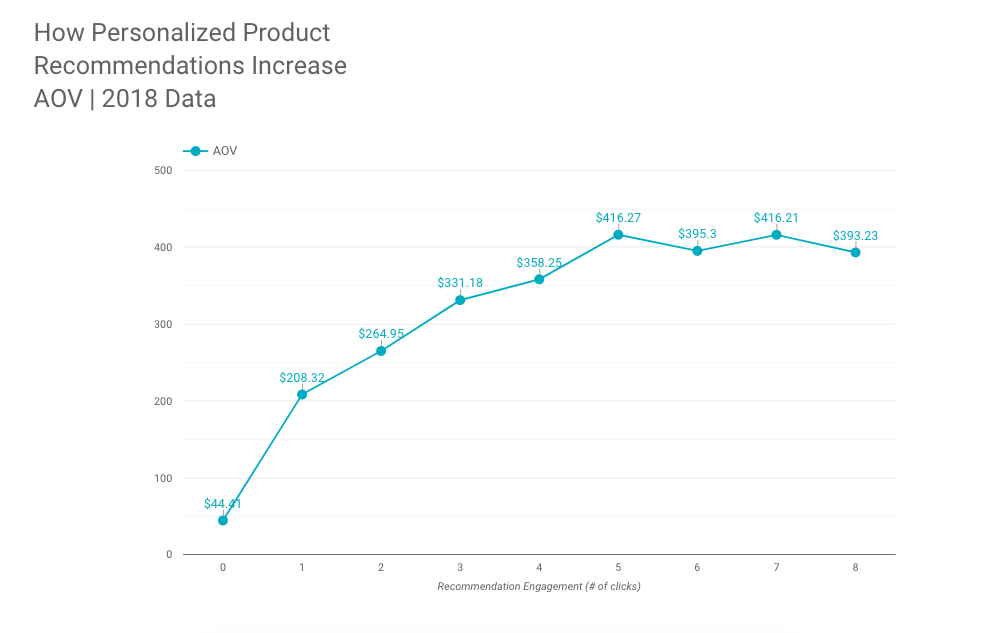 Impressive as they sound, the specific numbers aren’t the most important thing here.
Impressive as they sound, the specific numbers aren’t the most important thing here.
What really matters is the underlying point that the more you present customers with personalized recommendations, the more they’ll spend.
Brooklinen clearly recognizes this, tailoring its recommendations based on its newsletter subscribers’ browsing habits:
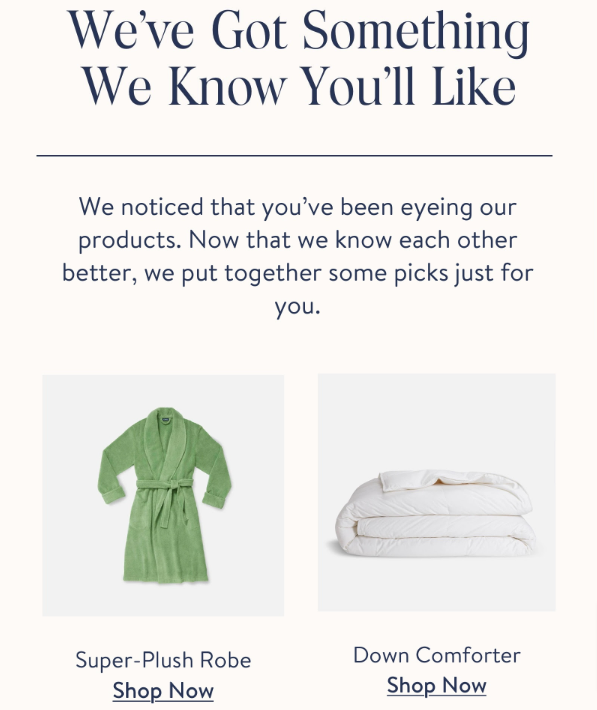
The product recommendations are the key element of this dynamic email, but they’re ably supported by smart email copywriting that explains how these products were chosen just for you.
2. Too Faced: Re-Engage Shopping Cart Abandoners
Transactional emails are a whole subcategory of dynamic emails.
In many ways, they’re the final word in personalization, because they’re directly triggered by the recipient’s behavior.
Abandoned cart emails are a classic example.
Your customer added an item to cart started the checkout process, then ditched it before completion—so you follow up with an abandoned cart email that prompts them to complete the transaction (possibly by including some kind of incentive).
While every ecommerce brand worth its salt will have an abandoned cart email template, each of those emails is sent individually and targeted at a single cart abandoner.
You can’t get more dynamic than that.
Precisely because they’re so targeted, abandoned cart emails consistently see open rates of 40+ percent. That’s twice as high as the average open rate across all industries and email types, as reported by one study.
Too Faced is one brand that understands the value of abandoned cart emails.
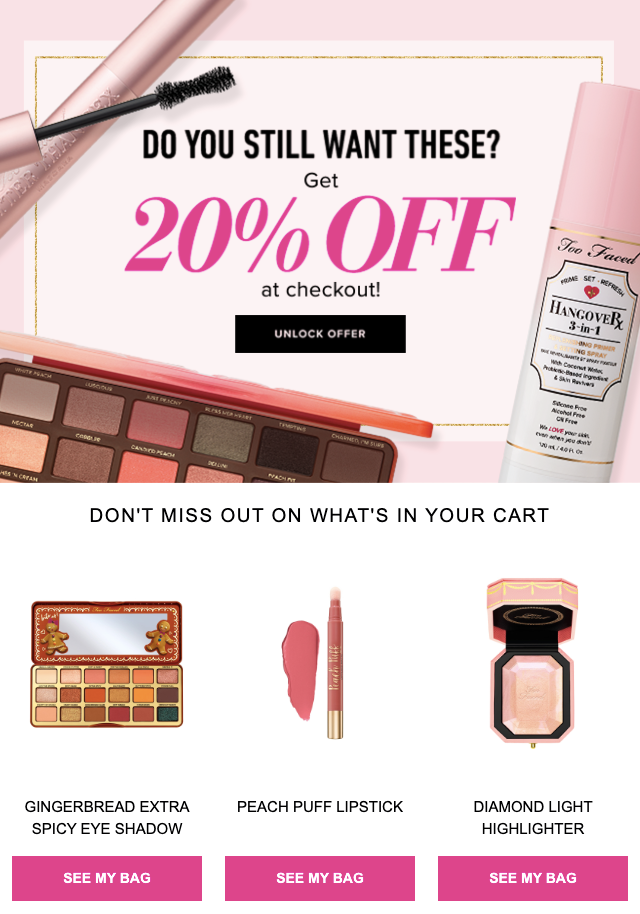
This example contains all the elements you need in a successful abandoned cart email:
- A compelling reason to complete the transaction (in this case, a 20 percent discount)
- Imagery and descriptions that remind us of the products we abandoned
- Clear calls to action that make it easy for us to pick back up where we left off
3. Kina and Tam: Create Dynamic Subject Lines
I’ve spoken plenty of times in the past about the importance of writing personalized email subject lines.
There’s a simple reason for that: they work.
According to Data Axle, consumers open emails with personalized subject lines at a 50 percent higher rate than emails without personalized subject lines.
But despite this, only a tiny proportion—2.3 percent— of emails actually employ personalization in the subject line.
To make matters worse, half of the emails that do have personalized subject lines use nothing more advanced than first name/last name personalization.
That might have worked a decade ago, but today, consumers expect more sophisticated personalization.
Specifically, they want targeted personalization based on things like their loyalty program status, browsing behavior, and purchase history.
Here’s an example of how to do subject line personalization well, courtesy of clothing brand Kina and Tam:

This subject line is tailored based on a specific product category we’ve recently engaged with.
The logic here is sound: we’re clearly interested in polo shirts, because we’ve been browsing them, but we evidently haven’t found the right one just yet—so it stands to reason that we’d appreciate some personalized recommendations from the same category.
That’s so much more meaningful than basically saying: “Hi {first.name}, want to buy something today?”
4. Chairish: Celebrate Customer Loyalty
Loyal customers are definitely something to celebrate.
According to Zendesk, 74 percent of customers feel loyal to a particular brand or company, while 52 percent report going out of their way to buy from their favorite brands.
So if you’ve got a customer who’s stuck with you through thick and thin—especially during the trying times of the pandemic and the subsequent supply chain crisis—it’s definitely worth saying “thank you”.
Chairish is well aware of this.
In this dynamic email example, it reaches out to a customer who’s been subscribed to its marketing list for four years:
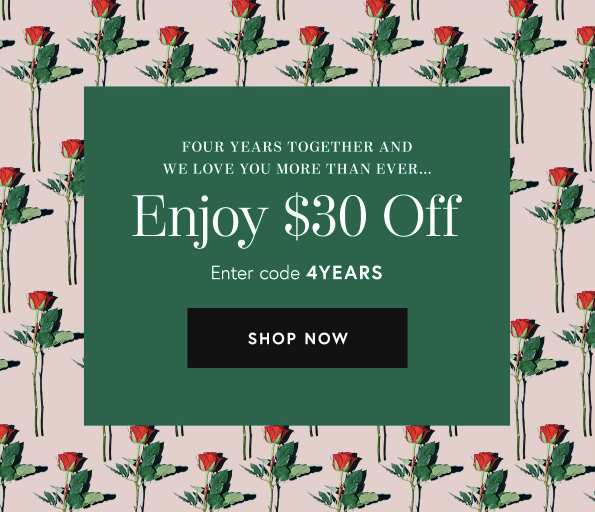
Chairish was only established in 2013, so this customer has been a big part of the brand’s journey.
Given that Google and other mailbox providers take active steps to flag up emails we never engage with, there’s a strong chance that this particular customer has been regularly opening Chairish’s email content (and perhaps clicking through and purchasing, too).
So it makes sense to reward them with a personalized coupon code to use on their next purchase.
5. Sephora: Share Loyalty Program Updates
In the last two examples, I discussed the importance of crafting personalized subject lines and the value of engaging loyal customers.
So in this next example, I decided to bring the two together.
Loyalty programs are one of the most effective ways to build longer-lasting, more valuable relationships with customers.
When asked what sort of actions they’d be willing to take for brands they feel loyal to, nearly 68 percent of respondents to a Yotpo survey said they’d join the brand’s loyalty or VIP program, up from 59.8 percent in 2019.
Similarly, those willing to spend more on a brand to which they feel loyal jumped from 34.5 percent in 2019 to 56 percent in 2020.
Of course, if you’re going to run a loyalty program, it makes sense to let customers know how their actions are benefiting them.
This is precisely what Sephora does with this dynamic email subject line:

This is an intelligent approach because it doesn’t just demonstrate the material benefit of being part of Sephora’s loyalty program—it also encourages the customer to spend just a little bit more to unlock the next tier of loyalty rewards.
6. Fabletics: Boost Engagement With Dynamic Imagery
Up to this point, I’ve focused this article on personalized product recommendations and email copy.
Why?
Simple: because those are the easiest ways to add dynamic content elements to your email marketing.
But remember, dynamic content isn’t limited to words or product images; it can include any sort of email content.
Fabletics gives us another practical application by creating dynamic imagery incorporating the customer’s name and preferences:
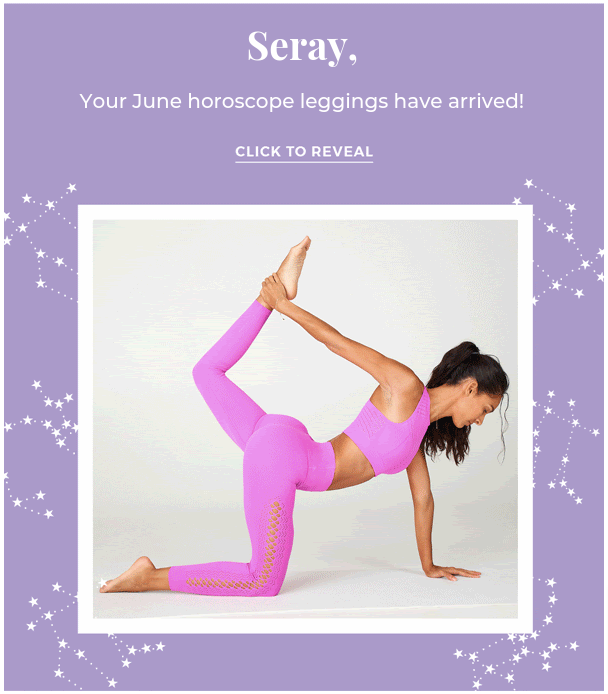
To be clear, this isn’t about adding personalization for the sake of it.
Dynamic images make for a more engaging email—and higher engagement means more clicks (and hopefully more sales).
Personalized gifts brand Getting Personal has used this tactic to drive real results. By adding dynamic name personalization to its emails, it saw:
- A 15 percent upturn in click-through rates
- A seven percent increase in conversion rates
- A 37 percent rise in sales
7. Design Within Reach: Share Dynamic End-of-Sale Alerts
Okay, back to the dynamic product recommendations for my final example.
I’ve already highlighted Brooklinen’s strategy of using previous browsing activity to serve newsletter subscribers with targeted (and highly relevant) recommendations.
Design Within Reach picks up that ball and runs with it.
Not only does it offer a personalized recommendation informed by a specific product we’ve “liked” in the past, but it informs us that the object of our affections is currently on sale:
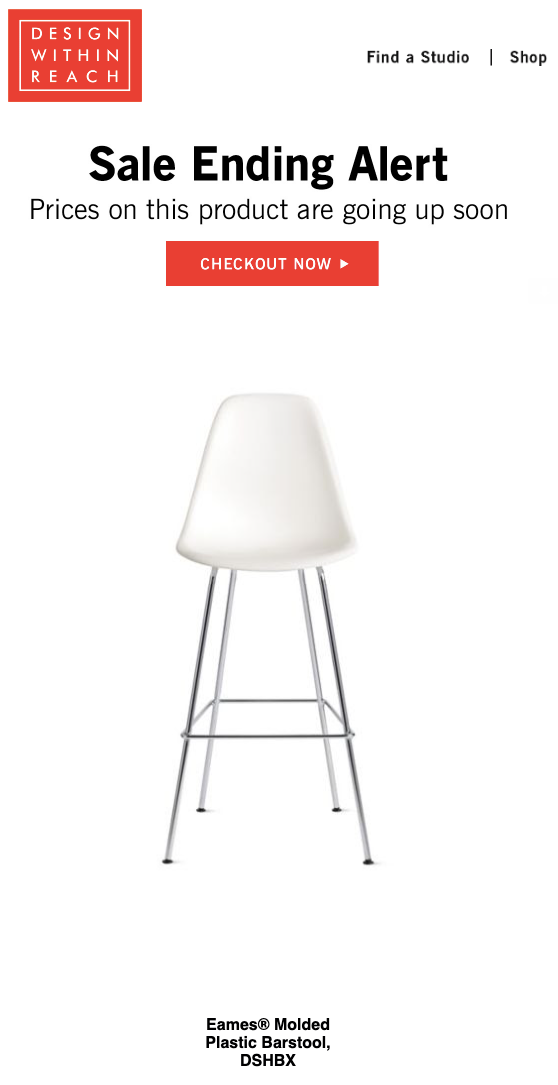
And it also warns us that if we don’t act soon, we’re going to miss out on the discount.
This is a powerful motivator because it plays into our natural fear of missing out.
That fear is so powerful, in fact, that 60 percent of Millennial consumers admit to making a reactive purchase after experiencing FOMO—most often within 24 hours.
If you can show your customers a product they love, then warn them that they’re at risk of missing out on a discount, you’ve got a great chance of driving an instant sale.
Segmentation Holds the Key to Engaging Dynamic Emails
It should be pretty clear from reading this article that you can’t do dynamic emails without effective segmentation.
If you can’t slice and dice your email list (metaphorically speaking, of course), you can’t reach leads and customers with content tailored to their behaviors and preferences.
So what if your segmentation strategy can’t take the strain?
Relax, Drip is here to help.
Want to reach customers who just browsed your thigh-high boot subcategory three months or bought a pair of gumshoes six weeks ago?
With Drip, you can target customers based on how they interact with your brand, allowing you to hit them with dynamically personalized content that speaks to them as individuals, not names on a vast email marketing list.
Sounds good?
Then why not sign up for your free 14-day trial.
It’ll only take a minute, and we won’t even ask for your credit card information. So what have you got to lose?

